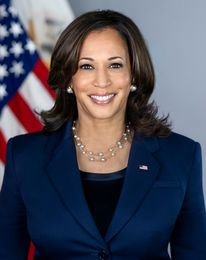I watched the Democratic National Convention on my hotel room TV while on a visit to one of the swing states in the US. Honestly, no place could have been a more opportune venue, other than the Chicago convention itself. Nothing has excited America more than next month’s presidential election, simply because the current Democratic candidate Kamala Harris, a mixed-race woman, is against an all-white (and a little orange) Republican Donald Trump.
Harris wore a pantsuit, a power dressing mandate in the sobering, so-boring, sartorial codes of America (if this was Europe, she would be in a mid-calf black dress hugging her every curve). The saving grace was perhaps that it was tan and by the stylish label Chloe.
Harris has hardly changed her wardrobe since she was announced as a presidential candidate. As vice-president, she dressed as safely as possible, so as to not distract from the focus on her work. Harris’s uniform has been tried-and-tested classic—tailored suits in black or neutrals, straight-leg trousers, Converse sneakers or then pointy pumps, and a gold link or pearl necklace.
She took a break from her uniform at the Phoenix Awards dinner in Washington, DC, when she wore a black sequin column dress from black American designer LaQuan Smith. But Harris is as neutral in her power suits as Hillary Clinton was bright in her rainbow-hued wardrobe.
Why is this so? Because Harris is playing to the conservative gallery, unlike Clinton, where the focus on her pantsuits went hand-in-hand with her nomination as the first female presidential candidate. Harris is toning down the feminist narrative, and notching up the race and migrant angle. Barack Obama was elected and Hillary was not, showing a trend that race matters more than gender to conservative America. Harris is using her subversion of feminine fashion to push for female and mixed-race representation. She is saying “don’t look at me, just listen to me”.
Women and clothing have long held a history with representation. Women were expected to be invisible to men in many societies, and were forced to dress as men to wander the streets in freedom. Shakespeare’s female characters (and those of all the other playwrights of 16th century England) were played by young boys dressed as women, as women were not permitted in the performing arts. One of the first women in the arts to dress like a man was Marlene Dietrich in 1933, for the film Riviera Days and Nights. She later paved the way for a women’s tuxedo followed by Greta Garbo, Katherine Hepburn and the iconic ‘Le Smoking’suit by Yves Saint Laurent.
Harris and women’s representation was on top of my mind when I watched Suffs, Shaina Taub’s iconic Broadway musical, short for the Women’s Suffrage movement in the US and across the world that allowed women the right to vote. Patronisingly ridiculed, and made small by being called ‘Suffragette’, men in power laughed off the movement with sexist jibes such as ‘She can’t take a joke’, ‘She sure as hell won’t shut up’, and the typical ‘She can’t get a man, so she’s a suffragette’. Quite similar to the ‘childless cat lady’trope, no?
Taub’s play is extraordinary in its craft. Not only does it turn the insults into songs, she also made women and non-binary performers play the male characters in the play! This is remarkable, as it renders men as invisible for the first time. And, by extension, quite unnecessary.
I do hope Harris wins the presidency, because what happens in America impacts the world. And what the world needs right now is representation and inclusion.
X@namratazakaria


